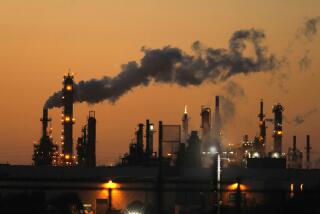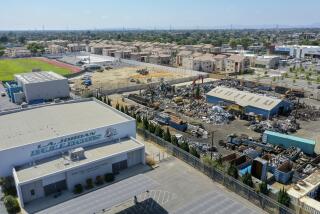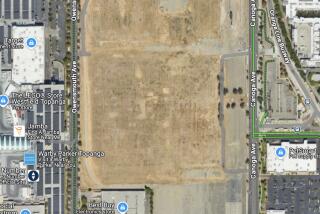Nuclear Weapons Plant Target of Federal Raid : Scores of Agents Descend on Facility Near Denver in Probe of Management of Radioactive Wastes
- Share via
DENVER — Nearly 100 federal agents clad in protective clothing raided the sprawling Rocky Flats nuclear weapons plant Tuesday as the Justice Department launched its first criminal investigation of such a facility.
Officials refused to say what triggered the probe, but a statement issued by the Justice Department in Washington, D.C., said it focuses on the storage, treatment and disposal of hazardous and radioactive wastes “in the past.”
Atty. Gen. Dick Thornburgh stressed that it “does not signal any major new environmental safety or health concern.”
Agents from the FBI and Environmental Protection Agency arrived at the Department of Energy facility at 9 a.m. to seize an undisclosed number of records, conduct sampling and interview employees, said Bob Pence, agent in charge of the FBI in Colorado.
No Arrests Made
There were no arrests and no part of the plant was shut down, authorities said.
Agents also searched the Albuquerque operations office of the Department of Energy, which oversees the Rocky Flats plant.
There was no immediate comment from officials at Rocky Flats, which manufactures plutonium triggers on a 6,500-acre site 16 miles northwest of Denver. The facility, which employs about 6,000 people, has been operated by Rockwell International for the government since 1975.
“They won’t tell us what the specific allegations are,” said Richard Marquez, spokesman for the DOE’s Albuquerque office. He said the search warrant did not name any individuals.
A spokesman at Rockwell headquarters in El Segundo, Calif., said only that the company was cooperating fully and that “this came as a surprise to us.”
Pence said the raid followed a two-year joint investigation by the FBI and EPA.
“We’re just getting started,” he said in a telephone interview, adding that the FBI “will maintain our presence in the plant on a 24-hour basis.”
Extensive Probe Expected
The search was expected to take approximately 10 days, but the Justice Department said the investigation itself would take six months to a year before any decision is made about filing charges. A federal grand jury inquiry into the plant operations also was under way in Denver, Thornburgh said.
The Justice Department said the specific allegations include “unpermitted treatment, storage and disposal of hazardous and mixed radioactive and hazardous wastes; the discharge of pollutants without a permit or in excess of permit limits; false certification of federal environmental reporting requirements, and concealment of environmental contamination.”
The statement said it was “too early in the investigation to say who is a target.
“The investigation conducted thus far suggests that environmental violations are occurring, but we will need to assess the results of this search and conduct further investigation to better determine whether that is in fact the case, and, if so, who is responsible.”
The Justice Department said that national security was not jeopardized because the search “is directed toward documents dealing with, and physical sampling of, hazardous waste--not the highly sensitive manufacturing and production processes but rather what is done with the hazardous wastes that are created.”
David Runkle, an assistant attorney general at the Justice Department, confirmed that it was the government’s first criminal investigation of a nuclear facility.
Pence said special precautions were taken for the agents who descended on Rocky Flats. All underwent medical examinations and attended safety and health lectures beforehand, he said, adding that “everyone is wearing special clothing” to protect against possible contamination.
Colorado’s Democratic governor, Roy Romer, complained that he was caught flat-footed by the raid, which he first learned about Tuesday afternoon.
After twice touring the controversial plant in the past to look at employee safety procedures, Romer said, “I felt that there were some mistakes in the past but was under the impression that they had been cleared up.
“Today, I have to say to the people: ‘Wait a minute, I don’t know.’ ”
Rocky Flats has been dogged by criticism and controversy over the past decade. Earlier this week, the Sierra Club filed suit over environmental concerns relating to the plant’s incinerators.
“Production concerns have been elevated over public health concerns, and there have been serious problems handling radioactive waste there,” said Tom Bernard of the anti-nuclear Colorado Peace Network.
Safety violations closed the plant’s main plutonium reprocessing building for four months last October. A December report by the Department of Energy listed 32 new safety problems and concluded that ground water contamination at Rocky Flats was the greatest single environmental hazard at any DOE facility.
Just last month, Congress was asked to finance a study to determine whether there is a link between pollution from Rocky Flats and cancer cases or birth defects in metropolitan Denver. The city has a population of about 2 million.
The proximity of the plant to the metropolitan area also became a key issue last year when boxcars of radioactive waste backed up at Rocky Flats when the state of Idaho refused to accept any more shipments until the federal government set a date for opening a permanent disposal site in Carlsbad, N.M.
Lab Near Chatsworth
A Department of Energy official said Tuesday the probe does not appear to extend to Rockwell’s Santa Susana Field Laboratory just west of Chatsworth, where the company for more than three decades has done nuclear power research for the government. The Department of Energy has documented chemical and radioactive pollution problems at the lab two miles southeast of Simi Valley, and recent news reports alleged that environmental officials weren’t fully informed about waste disposal practices at the site.
Unlike Rocky Flats, there is no data showing that contamination at Santa Susana has migrated off site.
Staff writers Robert L. Jackson in Washington, Myron Levin in Los Angeles and researcher Lisa Romaine in Denver contributed to this article.
More to Read
Sign up for Essential California
The most important California stories and recommendations in your inbox every morning.
You may occasionally receive promotional content from the Los Angeles Times.










